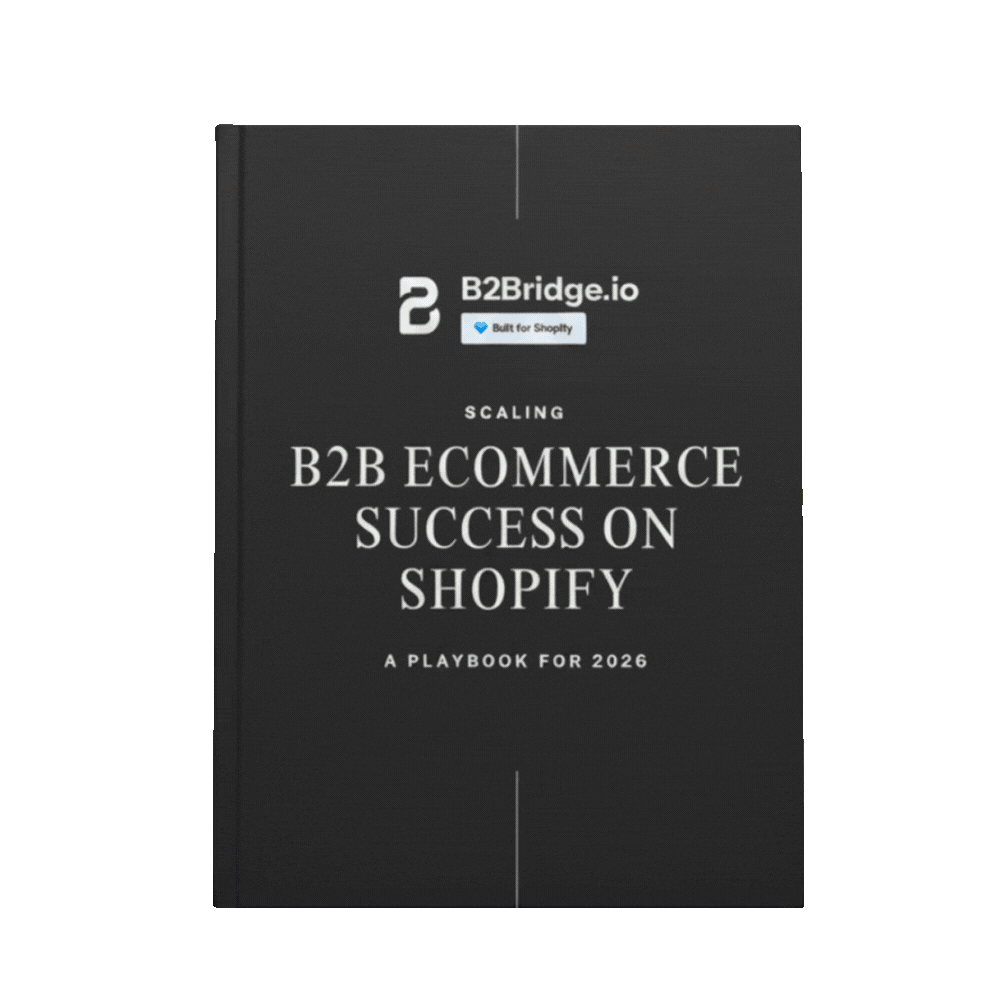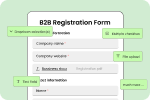PIM stands for Product Information Management. It is a software system that centralizes, manages, and enriches all product-related information in one platform.
Studies show that 93% of B2B buyers prefer to buy online when they’ve decided what to purchase, yet 46% of B2B organizations struggle with managing product content across channels. B2B buyers typically interact with 27 pieces of content before making a purchase decision, making comprehensive, accurate product information absolutely critical.
This comprehensive guide explores everything about B2B PIM: how B2B PIM works, what makes it essential for wholesale and distribution, the specific features B2B businesses require, and how to implement PIM to accelerate sales cycles, improve customer satisfaction, and scale operations efficiently.
What is B2B Product Information Management (PIM)?
B2B Product Information Management (PIM) is a specialized software solution and business practice designed to collect, consolidate, manage, and distribute product information specifically for business-to-business commerce. While the core concept mirrors B2C PIM, B2B PIM systems handle significantly more complexity related to business buying processes.
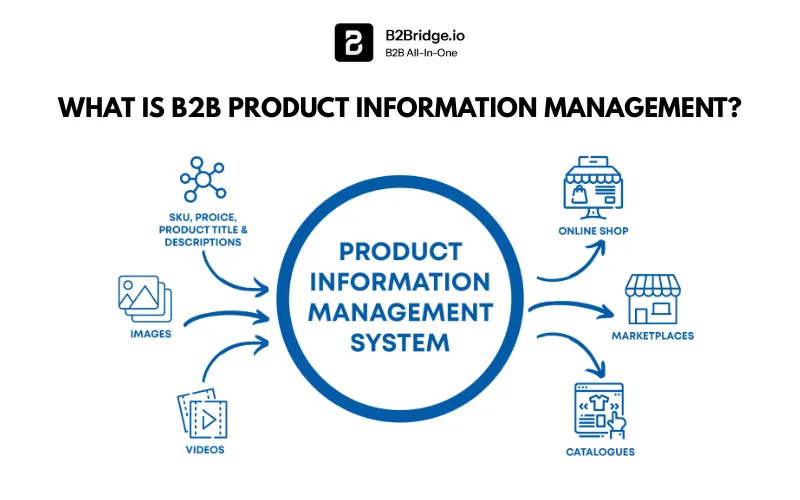
At its foundation, B2B Product Information Management (PIM) serves as the single source of truth for all product data used across your wholesale operations – from technical specifications and engineering documents to customer-specific pricing, contract terms, and compliance certifications. It’s where data from manufacturers, engineers, suppliers, and internal teams converges, gets validated and enriched, and then flows out to B2B customer portals, sales teams, distributor networks, and procurement systems.
The key roles of B2B Product Information Management (PIM) extend across the entire business buying journey. For sales teams, PIM provides instant access to detailed product specifications, cross-reference data, and customer-specific pricing needed to close deals quickly. For procurement professionals at customer organizations, PIM ensures they can find technical details, compare specifications, access safety data sheets, and verify compliance requirements. For operations teams, PIM maintains the complex relationships between products, replacements, compatible items, and system configurations.

How B2B PIM Works: The Complete Workflow
Understanding how B2B Product Information Management (PIM) works reveals how it transforms complex wholesale operations. The B2B PIM workflow encompasses six critical stages optimized for business sales.
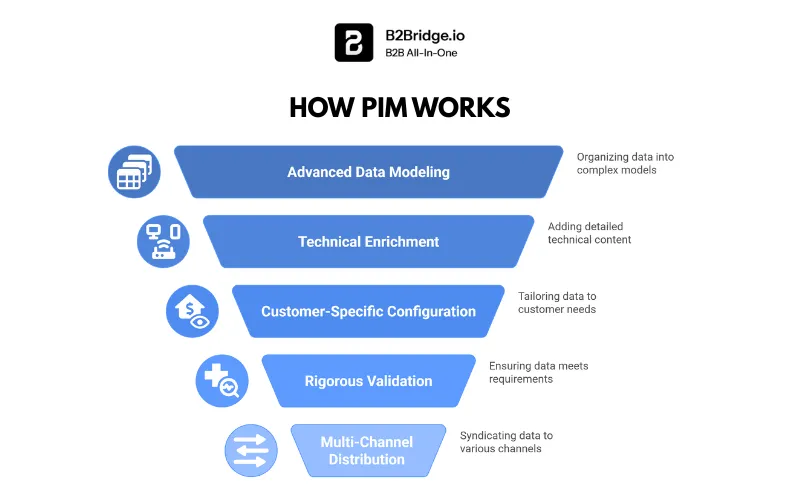
Stage 1: Multi-Source Data Collection
B2B product data originates from more complex sources than B2C. Manufacturers supply technical specifications, engineering data, and certification documents through various formats – EDI feeds, API connections, or comprehensive specification sheets. Your ERP system provides SKU data, multi-tier pricing structures, customer contract pricing, inventory levels across multiple warehouses, and supplier relationships. Engineering teams contribute CAD files, technical drawings, bill of materials, and configuration rules. Third-party sources provide cross-reference data, competitive intelligence, and industry standard specifications.
B2B Product Information Management (PIM) systems accommodate this complexity through robust import mechanisms: real-time API integrations with ERPs and PLM systems, automated parsing of complex spreadsheets and technical documents, batch processing for large-scale data updates, and sophisticated mapping tools that normalize data from disparate sources into consistent formats.
Stage 2: Advanced Data Modeling and Organization
Once imported, B2B Product Information Management (PIM) organizes products using complex data models that reflect business buying realities. The system creates hierarchical product families and configurations, establishes intricate relationships including compatible products, replacement parts, and system components, manages product variants by pack size, voltage, regional specifications, and other B2B-relevant attributes, and structures technical attributes specific to your industry – whether electrical specifications for components, chemical compositions for raw materials, or dimensional tolerances for manufactured parts.
B2B PIM also manages customer-specific product hierarchies. Different customers may have different category structures, custom product names, or preferred organizational schemes. The PIM accommodates these variations while maintaining a single master product record.
Transform your B2B store with B2Bridge.
Discover how B2Bridge can transform your wholesale business.
Schedule a demo today to see our payment management tools in action.
Stage 3: Technical Enrichment and Documentation
B2B enrichment focuses on comprehensive technical content rather than emotional marketing. Product managers add detailed specifications, performance characteristics, and technical standards compliance. Technical writers create installation guides, maintenance instructions, and troubleshooting documentation. Engineers attach CAD files, dimensional drawings, and material certifications.
Compliance specialists ensure products have proper safety data sheets (SDS), regulatory certifications, country-of-origin documentation, and industry-specific compliance information like RoHS, REACH, or FDA approvals. For B2B Product Information Management (PIM), completeness of technical documentation directly impacts sales velocity – buyers cannot complete procurement without this information.
Sales enablement teams add competitive comparisons, application notes, case studies, and ROI calculators. They create customer-specific content that addresses particular industry challenges or use cases. Cross-reference specialists map manufacturer part numbers to competitor equivalents, enabling easy product substitution and competitive displacement.
Stage 4: Customer-Specific Configuration
This stage is unique to B2B Product Information Management (PIM). The system manages customer-specific variations: contract pricing that overrides standard pricing, custom B2B product catalogs showing only products a customer is authorized to purchase, negotiated terms and minimum order quantities, customer-preferred product names and internal part numbers, and account-specific inventory reservations or allocation rules.
Large B2B customers may have dozens of locations, each with different shipping addresses, billing arrangements, and product needs. The PIM manages these complexities while maintaining data consistency.
Stage 5: Rigorous Validation for Business Requirements
B2B Product Information Management (PIM) validation goes beyond basic completeness checks. The system verifies technical specifications meet industry standards, pricing matrices are complete across all customer segments and volume tiers, required certifications and documentation are current and not expired, product compatibility rules are logically consistent, and regulatory requirements are met for each target market and industry.
Approval workflows involve more stakeholders in B2B: product management, technical specialists, legal/compliance, sales leadership for pricing approval, and potentially customer representatives for private label or custom products. The audit trail capabilities are essential for contract compliance and regulatory requirements.
Stage 6: Multi-Channel B2B Distribution
B2B Product Information Management (PIM) syndicates data to business-specific channels: your B2B Ecommerce portal or customer self-service site receives complete product data with customer-specific pricing and catalogs, sales teams access PIM through CRM integrations for quote generation, EDI systems receive feeds for automated order processing with trading partners, distributor and dealer portals get appropriate product information based on their authorization levels, procurement systems at customer organizations can integrate directly via API, and digital catalogs provide downloadable PDFs with technical specifications.
The distribution engine respects customer-specific rules – Customer A sees negotiated pricing while Customer B sees standard wholesale pricing. Product visibility is controlled based on contracts, geographic territories, or industry segments.
The B2B Continuous Cycle
B2B Product Information Management (PIM) operates continuously as products evolve, new technical documentation becomes available, pricing changes require updates, customer contracts are renegotiated, compliance certifications are renewed, and new products are introduced. Real-time dashboards provide visibility into data completeness by customer segment, pending approvals for pricing or technical changes, compliance document expiration dates, and sync status across all B2B channels.
Key Features and Functions of B2B PIM
B2B Product Information Management (PIM) requires specialized features beyond basic product management.
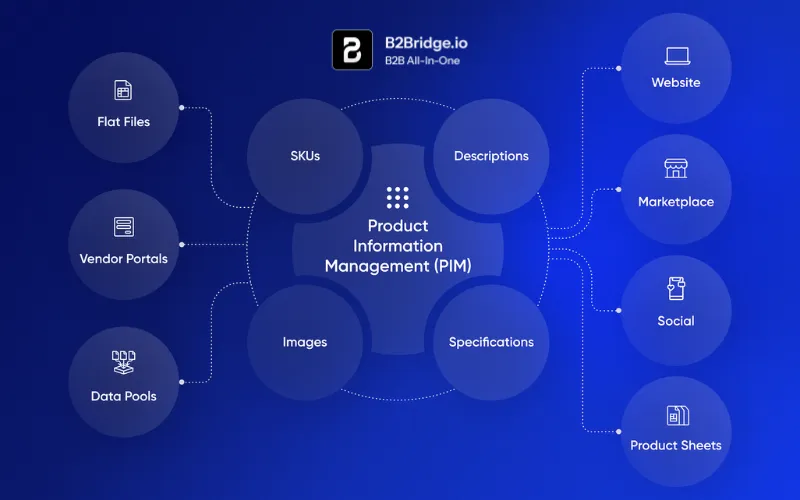
Complex Data Modeling
B2B PIM handles intricate product structures: configurable products with options and rules (if selecting Option A, then Option B is required), product families with shared specifications, kit and assembly management with component tracking, and multi-level product hierarchies reflecting business buying categories. The data model supports extensive technical attributes specific to your industry, from electrical specifications to chemical compositions to dimensional tolerances.
Customer-Specific Product Management
This critical B2B capability manages customer-specific pricing including contract pricing, volume discounts, and promotional pricing, custom product catalogs and assortments by customer, account-specific product names and internal part numbers, minimum order quantities and pack sizes by customer, and product availability and allocation rules by customer segment or territory.
Advanced Pricing Management
B2B Product Information Management (PIM) handles complex pricing scenarios: multi-tier pricing based on volume thresholds, customer-specific contract pricing with expiration dates, promotional pricing with date ranges and customer eligibility, cost-plus pricing formulas, and currency management for international B2B sales. The system maintains pricing history for audit purposes and supports quote generation with real-time pricing calculations.
Technical Documentation Management
Beyond basic product descriptions, B2B PIM manages CAD files and 3D models, technical drawings and schematics, installation and maintenance guides, safety data sheets (SDS) and certifications, compliance documentation and test reports, application notes and engineering bulletins, and warranty information and service documentation. Version control ensures users always access current documentation while maintaining historical records.
Cross-Reference and Compatibility
B2B buyers often search by competitor part numbers or need replacement parts. B2B Product Information Management (PIM) manages manufacturer part number cross-references to distributor SKUs, competitive cross-references enabling product substitution, compatibility matrices showing which products work together, replacement part relationships, and superseded product tracking when items are discontinued.
Digital Asset Management for Technical Content
B2B DAM requirements differ from B2C: high-resolution technical photography with measurements and callouts, CAD files in multiple formats (STEP, IGES, etc.), video demonstrations of installation or operation, virtual product tours for complex equipment, compliance certificates and test reports, and multilingual technical documentation for global operations.
Multi-Level User Permissions
B2B Product Information Management (PIM) supports complex user hierarchies: internal teams with different access levels by role, sales reps who access only products in their territory, distributor and dealer partners with appropriate wholesale visibility, and potentially customer users who view account-specific catalogs. Role-based permissions control who can view pricing, edit specifications, approve changes, or publish content.
Workflow Automation for B2B Complexity
Automated workflows handle multi-step approval processes for pricing changes requiring sales management approval, technical content requiring engineering sign-off, compliance documentation requiring legal review, and customer-specific configurations requiring account management approval. The system routes items through appropriate reviewers and maintains complete audit trails.
B2B Analytics and Reporting
B2B PIM provides insights into product information completeness by customer segment, time-to-market for new product introductions, data quality metrics and certification expiration tracking, product performance analysis by customer type, and content utilization showing which technical documents are most accessed.
Types of Data Managed by B2B PIM
B2B Product Information Management (PIM) handles data categories critical for business buyers:
- Technical Specifications: Detailed performance characteristics, dimensional data with tolerances, material compositions and grades, electrical/mechanical/chemical properties, operating parameters and environmental limits, and industry standard compliance (ISO, ANSI, DIN, etc.).
- Engineering Documentation: CAD files in multiple formats, technical drawings and schematics, bill of materials (BOM) for assemblies, manufacturing specifications, and engineering change notices (ECN) tracking revisions.
- Pricing and Contract Data: Standard wholesale pricing, customer-specific contract pricing, volume-based pricing tiers, promotional pricing with eligibility rules, cost information for margin analysis, and pricing effective dates and expiration.
- Compliance and Regulatory Information: Safety data sheets (SDS/MSDS), regulatory certifications (UL, CE, FDA), environmental compliance (RoHS, REACH, WEEE), country-of-origin documentation, conflict minerals declarations, and industry-specific certifications.
- Inventory and Availability Data: Stock levels by warehouse location, lead times for made-to-order items, minimum order quantities, pack sizes and order multiples, allocation and reservation information, and substitute product availability.
- Cross-Reference and Compatibility Data: Manufacturer part numbers, competitor equivalents for cross-selling, compatible products and systems, replacement parts for discontinued items, and supersession chains tracking product evolution.
- Customer-Specific Information: Custom product catalogs by account, account-specific product names, internal customer part numbers, contract te
- rms and special handling, and customer-specific documentation or certifications.
- Relationship and Configuration Data: Product family hierarchies, configurable product rules, accessory and add-on relationships, system and solution bundling, and application-specific recommendations.
Business Benefits of B2B PIM
Organizations implementing B2B Product Information Management (PIM) realize substantial benefits across sales, operations, and customer satisfaction.
Accelerated Sales Cycles: B2B buyers conduct extensive research before contacting sales. Complete, accurate product information reduces the time buyers spend gathering details. Sales teams equipped with comprehensive data through PIM-integrated CRMs can generate quotes faster and answer technical questions immediately. Companies report reducing sales cycle length by 30-40% after implementing B2B PIM, directly impacting revenue and sales productivity.
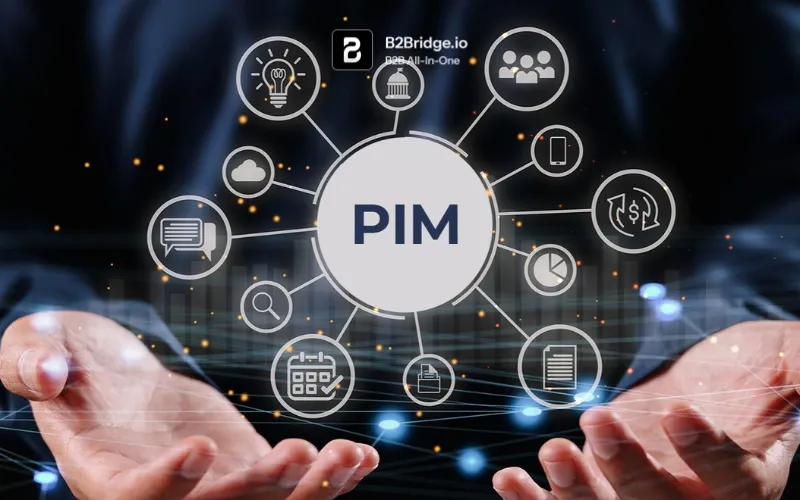
Increased Order Accuracy and Reduced Returns: Technical specification errors in B2B have costly consequences – wrong products disrupt production, require expensive returns, and damage relationships. B2B Product Information Management (PIM) ensures buyers select correct products by providing comprehensive specifications, compatibility information, and application guidance. Organizations report 50-70% reductions in order errors and returns due to specification mistakes.
Enhanced Customer Self-Service: B2B buyers increasingly prefer self-service for research and routine reordering. PIM enables robust self-service portals where customers can search by technical specifications, compare products, access documentation, and place orders without sales involvement. This reduces costs while improving customer satisfaction – studies show 80% of B2B buyers prefer digital self-service for routine purchases.
Faster Time-to-Market for New Products: Introducing new products across distributor networks, dealer channels, and customer portals traditionally takes months. B2B Product Information Management (PIM) reduces this to weeks or days by centralizing enrichment and enabling simultaneous distribution to all channels. Manufacturers report 60% reductions in time-to-market for new product launches.
Improved Distributor and Partner Enablement: Distributors and dealers need comprehensive product information to sell effectively. PIM provides partners with technical documentation, competitive positioning, and sales tools, improving their effectiveness. Better-informed partners generate more sales while requiring less manufacturer support.
Reduced Operational Costs: Manual product data management across systems is expensive and error-prone. B2B Product Information Management (PIM) automation eliminates redundant data entry, reduces errors requiring correction, and frees staff for higher-value activities. Companies report 40-50% reductions in product data management costs.
Stronger Compliance and Risk Management: Regulatory compliance is critical in B2B, particularly for industrial, chemical, food, and healthcare products. PIM centralizes compliance documentation, tracks certification expiration dates, and ensures required information accompanies products to each market. This reduces compliance risk and simplifies audits.
Better Customer Experience and Retention: B2B buyers expect experiences comparable to B2C – comprehensive information, easy search, and seamless transactions. B2B Product Information Management (PIM) enables these experiences, improving customer satisfaction and retention. Studies indicate that superior digital experiences increase B2B customer lifetime value by 20-30%.
Implementation Best Practices for B2B PIM
Successfully implementing B2B Product Information Management (PIM) requires understanding B2B-specific challenges:
Define Your B2B Data Model First
Before selecting PIM software, map your product data requirements. Identify all technical attributes, customer-specific data needs, pricing complexity, and compliance requirements. Document product relationships, configurations, and hierarchies. This foundation ensures you select PIM software that handles your complexity and implement it correctly from the start.
Prioritize ERP and CRM Integration
B2B PIM success depends on seamless integration with your ERP and CRM systems. ERP integration enables real-time inventory, pricing, and customer contract data. CRM integration empowers sales teams with product information during customer interactions. Prioritize these integrations early and invest in robust API connections rather than batch file transfers.
Address Customer-Specific Requirements
Plan how you’ll handle customer-specific catalogs, pricing, and product names. Design workflows for maintaining customer-specific data at scale. Consider how you’ll onboard new customers and migrate existing customer-specific configurations from legacy systems.
Establish Technical Content Standards
Define standards for technical documentation, specifications, and compliance data. Create templates for consistent data entry. Establish quality benchmarks for completeness – what information must every product have before it can be published? Document naming conventions for technical files and assets.
Plan for Complex Approval Workflows
B2B product information often requires multiple approvals – technical, pricing, legal, compliance. Design workflow processes that balance thoroughness with speed. Identify who must approve what types of changes and implement appropriate routing.
Train Sales and Customer Service Teams
PIM success requires user adoption across customer-facing teams. Train sales reps on accessing product data through CRM integration. Educate customer service on using PIM to answer technical questions. The investment in training directly impacts customer experience quality.
Design for Distributor and Partner Access
If you sell through distribution channels, plan how distributors will access product information. Will they have PIM portal access? Receive feeds? Integration with their systems? Designing partner access into your initial implementation prevents later complications.
Implement Phased Rollout
B2B catalogs often contain thousands or millions of SKUs. Attempting to enrich everything at once overwhelms teams. Implement phased rollout starting with strategic product families, new products, or best-sellers. Use success metrics to refine processes before expanding.
Maintain Audit Trails and Version Control
B2B transactions often involve contracts and regulatory requirements. Ensure your B2B Product Information Management (PIM) maintains complete audit trails showing who changed what information and when. Version control for technical documentation and certifications is essential.
Monitor and Optimize Continuously
Track metrics like data completeness by product category, time from product creation to publication, customer self-service utilization rates, and reduction in sales cycle length. Use these metrics to identify improvement opportunities and demonstrate PIM ROI to leadership.
Real-World Use Case: B2B PIM in Industrial Distribution
Consider a large industrial distributor carrying 500,000 SKUs from 1,200 manufacturers, selling to contractors, facility managers, and industrial buyers across North America. Before implementing B2B Product Information Management (PIM), they struggled with incomplete product specifications, inconsistent data across their website and sales systems, inability to provide customer-specific pricing and catalogs at scale, and lengthy processes for adding new products or manufacturers.
Their B2B PIM implementation began by integrating with their ERP system to import SKUs, pricing, and inventory data automatically. Manufacturer partners provided product specifications through various formats – some via EDI, others through spreadsheet uploads, and major suppliers via API integration. The PIM normalized this disparate data into consistent technical attributes.
Their product enrichment team used B2B Product Information Management (PIM) workflows to add detailed specifications, application information, and cross-references to competitor products. Technical writers uploaded installation guides, safety data sheets, and specification documents. For strategic product categories, they added CAD files and dimensional drawings. Photography specialists linked product images, detail shots, and application photos.
Customer-specific configuration was critical. Their 50,000+ customer accounts had varying needs – some negotiated contract pricing, others required custom catalogs showing only relevant products for their industry, and major accounts needed specific product names matching their internal systems. The PIM managed these variations efficiently.
The distribution channels were diverse. Their B2B Ecommerce site received complete product data with customer-specific pricing calculated in real-time based on contracts and volume tiers. Mobile apps used by field service contractors received streamlined data optimized for quick product lookup. Sales reps accessed product information through CRM integration, enabling them to generate accurate quotes including technical specifications. Major customers with procurement system integrations received catalog feeds tailored to their formats and requirements.
The measurable results were impressive. Time to add new manufacturer product lines decreased from 3-6 months to 2-4 weeks. Online conversion rates increased 35% due to comprehensive product specifications and cross-reference data helping buyers find correct products. Sales cycle length decreased 28% as buyers found information independently and sales reps generated quotes faster. Customer self-service order volume increased 45%, reducing customer service costs. Product information errors that led to returns decreased 62%. The distributor successfully expanded into new product categories and geographic markets that were previously impossible with their manual processes.
Emerging Trends in B2B PIM
The B2B Product Information Management (PIM) landscape continues evolving to address emerging business needs.
AI-Powered Technical Content Generation
Artificial intelligence is transforming B2B content creation. AI can generate initial technical descriptions from specification sheets, automatically categorize products based on attributes, extract technical specifications from manufacturer documents, suggest cross-references by analyzing product similarities, and identify missing technical information that buyers need. While human review remains essential for accuracy, AI dramatically accelerates content creation for large catalogs.
Enhanced Configurator Integration
Complex B2B products often require configuration – selecting options, add-ons, and specifications. Modern B2B Product Information Management (PIM) increasingly integrates with CPQ (Configure, Price, Quote) systems, providing configuration rules, pricing logic, and product relationships that enable guided selling. Buyers can configure complex products while PIM ensures only valid combinations are possible.
Improved Cross-Reference and Search
B2B buyers often search by manufacturer part numbers, competitor equivalents, or technical specifications. Advanced PIM systems now offer AI-powered search that understands technical terminology, parametric search enabling filtering by multiple technical specifications, visual search for industrial parts, and intelligent cross-reference suggestions based on application and specifications.
Sustainability and ESG Data Management
B2B buyers increasingly require environmental and social data for their own reporting and sustainability initiatives. B2B Product Information Management (PIM) is expanding to track carbon footprint data, recyclability and disposal information, ethical sourcing documentation, energy efficiency ratings, and environmental certifications. This data helps B2B customers meet their sustainability goals.
API-First Architecture for Integration
Modern B2B commerce requires seamless integration across systems. Next-generation PIM platforms adopt API-first architecture, enabling real-time data exchange with procurement systems at customer organizations, EDI platforms for automated trading, custom B2B applications and portals, and IoT systems that need product specifications.
Enhanced Mobile Experiences
B2B field sales reps, service technicians, and contractors increasingly use mobile devices. PIM platforms now optimize content delivery for mobile, provide offline access to critical product data, and enable mobile-based content contribution where field teams can photograph installations or document product issues.
Blockchain for Supply Chain Transparency
Some B2B industries are exploring blockchain integration with PIM to provide immutable audit trails of product data, verification of certifications and compliance claims, and supply chain transparency showing product origin and journey.
Glossary of Key B2B PIM Terms
- SKU (Stock Keeping Unit): Unique identifier for each distinct product, including variants by pack size, specification, or customer
- Cross-Reference: Mapping between different part numbers – manufacturer to distributor, or competitor equivalents
- CPQ (Configure, Price, Quote): Software enabling sales teams to configure complex products and generate accurate quotes
- EDI (Electronic Data Interchange): Automated exchange of business documents and data between organizations
- SDS/MSDS (Safety Data Sheet): Document containing chemical safety and hazard information, required for many B2B products
- Bill of Materials (BOM): List of components, parts, and materials required to assemble a product
- Parametric Search: Search capability enabling filtering by multiple technical specifications simultaneously
- Contract Pricing: Customer-specific pricing negotiated through contracts, overriding standard pricing
- Product Syndication: Automated distribution of product information to multiple channels and systems
- Data Enrichment: Process of adding technical specifications, documentation, and marketing content to basic product data
- Multi-Tier Pricing: Pricing structure with different rates based on volume thresholds or customer segments
Innovation in B2B PIM: Looking Forward
How is AI transforming B2B Product Information Management (PIM)?
Artificial intelligence is revolutionizing B2B content management. Machine learning algorithms analyze technical specification sheets and automatically extract structured data, eliminating manual data entry. Natural language processing generates initial technical descriptions from specifications, which humans then refine. Computer vision analyzes technical drawings and schematics to extract dimensional data automatically.
AI-powered cross-referencing analyzes product attributes to suggest competitor equivalents and compatible products, augmenting manual cross-reference efforts. Intelligent search understands technical terminology and buyer intent, helping procurement professionals find products even when searching with imprecise terms. Predictive analytics identify products likely to need updated specifications or documentation based on age, category, or usage patterns.
These AI capabilities don’t replace human expertise in B2B Product Information Management (PIM) but dramatically augment it, enabling small teams to manage enormous catalogs with quality that was previously impossible.
How does PIM support B2B digital transformation?
B2B digital transformation requires comprehensive, accurate product information as its foundation. B2B Product Information Management (PIM) enables self-service portals where buyers research and order independently, reducing sales costs while improving buyer experience. It supports mobile commerce for field sales and service technicians who need product information on-site. PIM enables personalization, showing different content to engineers versus purchasing agents versus executives.
Integration with emerging technologies depends on PIM. IoT devices in smart factories need product specifications to optimize operations. Augmented reality applications that help buyers visualize equipment in their facilities require 3D models from PIM. Voice commerce for reordering requires structured, searchable product data. B2B Product Information Management (PIM) provides the data layer enabling these innovations.
What role does PIM play in B2B marketplace expansion?
B2B marketplaces like Amazon Business, Alibaba, ThomasNet, and Grainger are growing rapidly. Each has unique product data requirements and formats. B2B Product Information Management (PIM) enables efficient participation by formatting your product catalog according to each marketplace’s specifications, syndicating updates automatically, and managing marketplace-specific content variations. Organizations using PIM can expand to new marketplaces in weeks rather than months, accessing new customer segments efficiently.
Strengthen Your B2B Shopify Store with B2Bridge
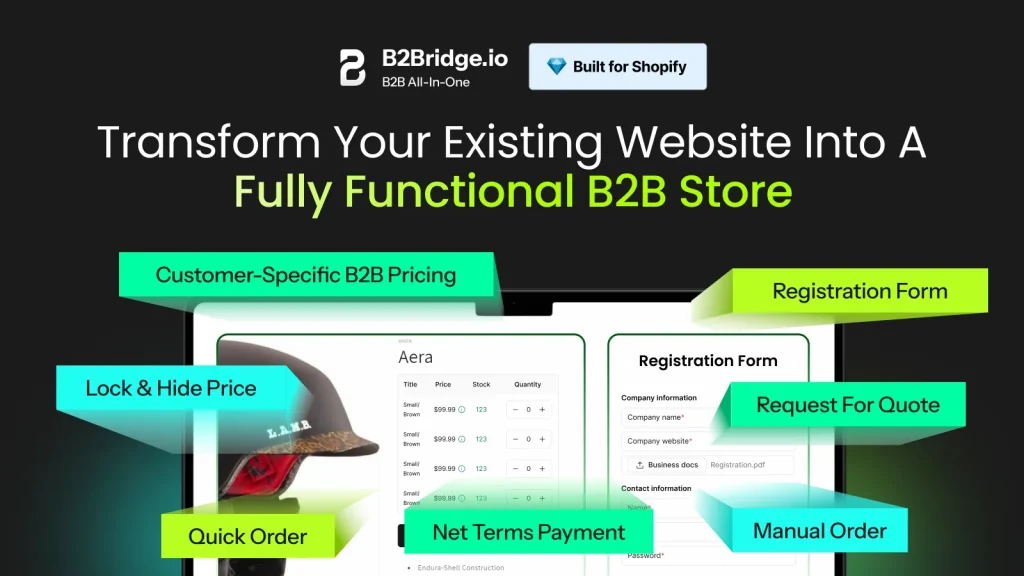
Managing product information is foundational to B2B success, but it’s just one piece of delivering exceptional business customer experiences. If you’re operating a B2B business on Shopify, you face challenges beyond product data – customer-specific pricing that PIM can’t handle alone, complex ordering workflows including quote requests and approval chains, bulk ordering capabilities that B2B buyers expect, and account management for multiple users within customer organizations.
B2Bridge’s Shopify app is specifically designed for wholesale and B2B sellers, providing essential capabilities that complement your product information management. B2Bridge enables customer-specific pricing and catalogs that integrate with your PIM data, quick order forms and bulk ordering for efficient B2B purchasing, quote management with approval workflows, customer account management with multiple users and roles, and seamless integration with Shopify and your existing systems.
Just as B2B Product Information Management (PIM) centralizes your product data, B2Bridge centralizes your B2B sales operations – enabling you to deliver the sophisticated, efficient buying experience that business customers demand. The combination of comprehensive product information from PIM and B2B-specific commerce capabilities from B2Bridge creates a powerful website for wholesale growth.
FAQs About B2B Product Information Management
While both centralize product information, B2B Product Information Management (PIM) handles significantly more complexity. B2B PIM manages customer-specific pricing, catalogs, and terms rather than single-price, single-catalog scenarios. It emphasizes detailed technical specifications and engineering documentation over emotional marketing content.
B2B PIM handles complex product configurations, compatibility rules, and cross-references essential for business buyers. It integrates more extensively with ERPs, CRMs, and procurement systems. The approval workflows are more rigorous, involving technical, pricing, and compliance reviews. B2B PIM also manages distributor and partner access with varying levels of authorization.
While these systems share some data, they serve different purposes. ERP manages transactional data – orders, inventory, financials – and treats products as inventory items. PLM handles product design and engineering during development. Product Information Management (PIM) specializes in enriching and distributing product information for marketing and sales. PIM takes technical data from PLM and transactional data from ERP, enriches it with marketing content and assets, and publishes it to customer-facing channels.
Yes, this is a core B2B PIM capability. Modern systems efficiently manage customer-specific variations for thousands of accounts. They use rules engines to determine pricing based on customer contracts, volume tiers, and promotional eligibility. Catalog visibility is controlled through customer segmentation, territory assignments, and contract terms. The system maintains these customer-specific configurations while still providing a single master product record, avoiding data duplication.
Integration is typically bidirectional through APIs. The ERP sends product SKUs, inventory levels, standard pricing, and supplier information to B2B Product Information Management (PIM). Customer account data including contract pricing and terms flows from ERP to PIM. PIM enriches this basic data with technical specifications, marketing content, and documentation. When products are updated in PIM, essential changes can sync back to ERP if needed. Real-time API integration enables dynamic pricing and inventory display on customer-facing channels.
B2B Product Information Management (PIM) is the foundation of effective self-service. It provides comprehensive product information that enables buyers to research independently, search and filtering capabilities by technical specifications, customer-specific pricing and catalogs automatically displayed based on login, technical documentation including specification sheets and installation guides, and cross-reference data helping buyers find replacement or alternative products. PIM enables the rich self-service experience that B2B buyers increasingly expect.
Conclusion
B2B Product Information Management (PIM) has evolved from a nice-to-have tool to an essential system for wholesale, distribution, and manufacturing organizations competing in today’s digital-first business environment. The unique complexities of B2B commerce – extensive technical specifications, customer-specific pricing and catalogs, rigorous compliance requirements, and multi-channel distribution – make specialized B2B PIM capabilities absolutely critical.
Start by assessing your current product information management challenges, define your requirements and goals, and explore PIM solutions that align with your business needs and growth trajectory. The journey to centralized, high-quality product information begins with a single step – and the competitive advantages it delivers make it a journey worth taking.
Ready to transform your B2B Shopify store? Explore how B2Bridge can complement your product information strategy with powerful B2B commerce features. Visit our Shopify App Store listing to learn more and start your free trial today.
Hi, I’m Ha My Phan – an ever-curious digital marketer crafting growth strategies for Shopify apps since 2018. I blend language, logic, and user insight to make things convert. Strategy is my second nature. Learning is my habit. And building things that actually work for people? That’s my favorite kind of win.
